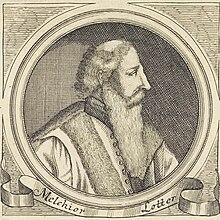
Desiderius Erasmus Roterodamus was a Dutch philosopher and Catholic theologian who is considered one of the greatest scholars of the northern Renaissance. As a Catholic priest, he was an important figure in classical scholarship who wrote in a pure Latin style. Among humanists he was given the sobriquet "Prince of the Humanists", and has been called "the crowning glory of the Christian humanists". Using humanist techniques for working on texts, he prepared important new Latin and Greek editions of the New Testament, which raised questions that would be influential in the Protestant Reformation and Catholic Counter-Reformation. He also wrote On Free Will,In Praise of Folly, Handbook of a Christian Knight, On Civility in Children, Copia: Foundations of the Abundant Style and many other works.
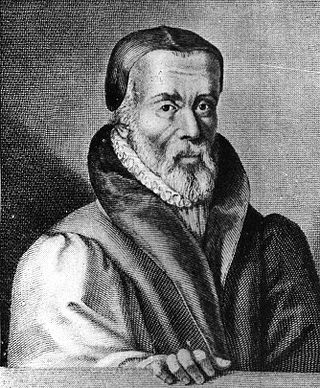
William Tyndale was an English biblical scholar and linguist who became a leading figure in the Protestant Reformation in the years leading up to his execution. He is well known as a translator of the Bible into English, and was influenced by the works of prominent Protestant Reformers such as Martin Luther.
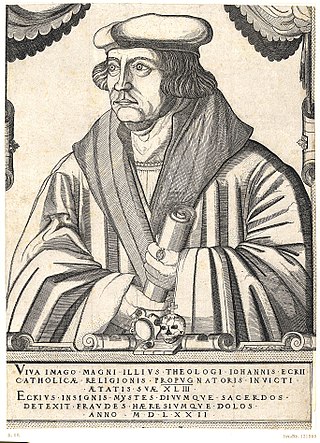
Johann Maier von Eck, often anglicized as John Eck, was a German Catholic theologian, scholastic, prelate, and a pioneer of the counter-reformation who was among Martin Luther's most important interlocutors and theological opponents.

Johann Reuchlin was a German Catholic humanist and a scholar of Greek and Hebrew, whose work also took him to modern-day Austria, Switzerland, Italy, and France. Most of Reuchlin's career centered on advancing German knowledge of Greek and Hebrew.

The Bible has been translated into many languages from the biblical languages of Hebrew, Aramaic, and Greek. As of 2022 all of the Bible has been translated into 1060 languages, the New Testament has been translated into an additional 1,617 languages, and smaller portions of the Bible have been translated into 1,248 other languages according to Wycliffe Global Alliance. Thus, at least some portions of the Bible have been translated into 3,589 languages.
This article contains information about the literary events and publications of 1522.

Andreas Rudolph Bodenstein von Karlstadt, better known as Andreas Karlstadt or Andreas Carlstadt or Karolostadt, or simply as Andreas Bodenstein, was a German Protestant theologian, University of Wittenberg chancellor, a contemporary of Martin Luther and a reformer of the early Reformation.

The German Renaissance, part of the Northern Renaissance, was a cultural and artistic movement that spread among German thinkers in the 15th and 16th centuries, which developed from the Italian Renaissance. Many areas of the arts and sciences were influenced, notably by the spread of Renaissance humanism to the various German states and principalities. There were many advances made in the fields of architecture, the arts, and the sciences. Germany produced two developments that were to dominate the 16th century all over Europe: printing and the Protestant Reformation.

Antilegomena are written texts whose authenticity or value is disputed. Eusebius in his Church History used the term for those Christian scriptures that were "disputed", literally "spoken against", in Early Christianity before the closure of the New Testament canon.

JeromeEmser, German theologian and antagonist of Luther, was born of a good family at Ulm.
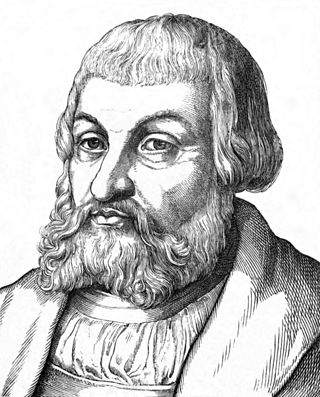
Caspar Aquila, born Johann Kaspar Adler, was a German Lutheran theologian and reformer.
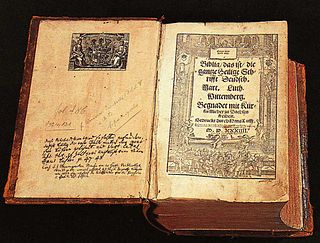
The Luther Bible is a German language Bible translation by Martin Luther. A New Testament translation by Luther was first published in September 1522, and the completed Bible, containing a translation of the Old and New Testaments with Apocrypha, in 1534. Luther continued to make improvements to the text until 1545. It was the first full translation of the Bible into German which made use of Greek texts, not just their Latin Vulgate translations. Luther did not translate the entire Bible by himself, rather he relied on a team of translators and helpers among them Melanchthon, a scholar of Koine Greek who motivated and assisted Luther's New Testament translation from Greek and Matthäus Aurogallus, a linguist and scholar of Hebrew.
Renaissance humanism came much later to Germany and Northern Europe in general than to Italy, and when it did, it encountered some resistance from the scholastic theology which reigned at the universities. Humanism may be dated from the invention of the printing press about 1450. Its flourishing period began at the close of the 15th century and lasted only until about 1520, when it was absorbed by the more popular and powerful religious movement, the Reformation, as Italian humanism was superseded by the papal counter-Reformation. Marked features distinguished the new culture north of the Alps from the culture of the Italians. The university and school played a much more important part than in the South according to Catholic historians. The representatives of the new scholarship were teachers; even Erasmus taught in Cambridge and was on intimate terms with the professors at Basel. During the progress of the movement new universities sprang up, from Basel to Rostock. Again, in Germany, there were no princely patrons of arts and learning to be compared in intelligence and munificence to the Renaissance popes and the Medici. Nor was the new culture here exclusive and aristocratic. It sought the general spread of intelligence, and was active in the development of primary and grammar schools. In fact, when the currents of the Italian Renaissance began to set toward the North, a strong, independent, intellectual current was pushing down from the flourishing schools conducted by the Brethren of the Common Life. In the humanistic movement, the German people was far from being a slavish imitator. It received an impulse from the South, but made its own path.

The biblical apocrypha denotes the collection of apocryphal ancient books thought to have been written some time between 200 BC and AD 400. The Roman Catholic, Eastern Orthodox and Oriental Orthodox churches include some or all of the same texts within the body of their version of the Old Testament, terming them deuterocanonical books. Traditional 80-book Protestant Bibles include fourteen books in an intertestamental section between the Old Testament and New Testament called the Apocrypha, deeming these useful for instruction, but non-canonical. To this date, the Apocrypha are "included in the lectionaries of Anglican and Lutheran Churches". Anabaptists use the Luther Bible, which contains the Apocrypha as intertestamental books; Amish wedding ceremonies include "the retelling of the marriage of Tobias and Sarah in the Apocrypha". Moreover, the Revised Common Lectionary, in use by most mainline Protestants including Methodists and Moravians, lists readings from the Apocrypha in the liturgical calendar, although alternate Old Testament scripture lessons are provided.

The doctrine of the Trinity, considered the core of Christian theology by Trinitarians, is the result of continuous exploration by the church of the biblical data, thrashed out in debate and treatises, eventually formulated at the First Council of Nicaea in AD 325 in a way they believe is consistent with the biblical witness, and further refined in later councils and writings. The most widely recognized Biblical foundations for the doctrine's formulation are in the Gospel of John, which possess ideas that originate in Platonism and Greek philosophy.

The Tyndale Bible (TYN) generally refers to the body of biblical translations by William Tyndale into Early Modern English, made c. 1522–1535. Tyndale's Bible is credited with being the first Bible translation in the English language to work directly from Hebrew and Greek texts, although it relied heavily upon the Latin Vulgate. Furthermore, it was the first English biblical translation that was mass-produced as a result of new advances in the art of printing.

Kurt Aland was a German theologian and biblical scholar who specialized in New Testament textual criticism. He founded the Institut für neutestamentliche Textforschung in Münster and served as its first director from 1959 to 1983. He was one of the principal editors of Nestle–Aland – Novum Testamentum Graece for the Deutsche Bibelgesellschaft and The Greek New Testament for the United Bible Societies.

Luther's canon is the biblical canon attributed to Martin Luther, which has influenced Protestants since the 16th-century Protestant Reformation. While the Lutheran Confessions specifically did not define a biblical canon, it is widely regarded as the canon of the Lutheran Church. It differs from the 1546 Roman Catholic canon of the Council of Trent in that it rejects the deuterocanonical books and questions the seven New Testament books, called "Luther's Antilegomena", four of which are still ordered last in German-language Luther Bibles to this day.
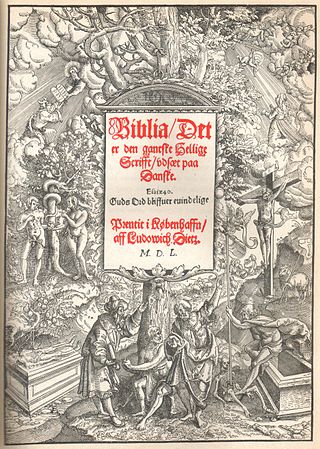
Bible translations in Norway date back to the late 13th century. Since the first spread of Christianity in Norway, numerous translations of the Bible have been published. Translations have appeared in several of the official languages that Norway has had throughout its history, including editions in Old Norse, Danish, and both current standard forms Nynorsk and Bokmål.
Christian Döring was a 16th-century figure of the Reformation, a wealthy goldsmith and one of the first publishers of the Bible in native German.
